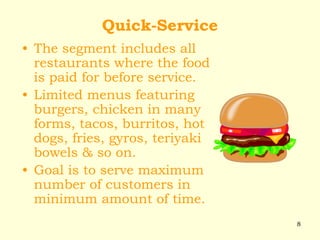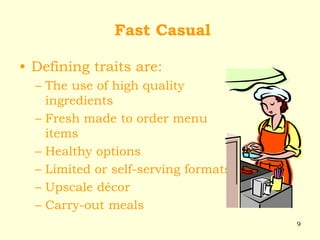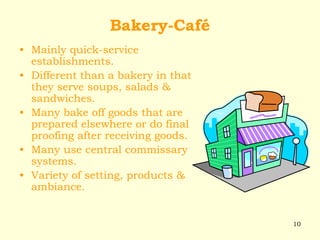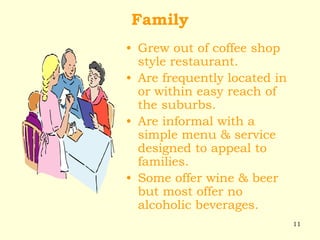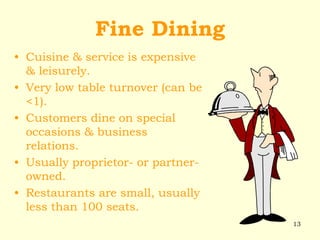1466372.ppt
- 1. Chapter 2: Kinds & Characteristics of Restaurants & Their Owners • Chain or Independent • Franchised • Quick-Service • Fast Casual • Family • Casual • Fine-Dining
- 2. 2 Kinds & Characteristics of Restaurants & Their Owners • Steak House • Seafood • Ethnic • Theme • Chef-Owned • Women Chefs & Restaurant Owners • Centralized Home Delivery
- 3. 3 Chain or Independent • Chain restaurants have some advantages & some disadvantages over independent restaurants. • The advantages include: recognition in the marketplace, greater advertising clout, sophisticated systems development & discounted purchasing.
- 4. 4 Chain or Independent • Independent restaurants are relatively easy to open. • The advantage for the independent restaurateur is that they can “do their own thing” in terms of concept development, menus, décor & so on. • Some independent restaurants will grow into small chains & larger companies will buy them out.
- 5. 5 Franchised Restaurants • Franchising involves the least risk: – Restaurant format, including building design, menu & marketing plans, have already been tested in the marketplace. – Less likely to go “belly up” than independent restaurants. – Training is provided. – Marketing & management supports are available.
- 6. 6 Franchised Restaurants • To open a franchise there is a franchising fee, a royalty fee, advertising royalty & requirements of substantial personal net worth. • Franchisors help: – Site selection – Review of any proposed sites – Assist with design & building preparation – Help with preparation for opening – Train managers & staff – Plan & implement pre-opening marketing strategies – Conduct unit visits & provide on-going operating advice
- 7. 7 Quick-Service • The Plate House, opened in the 1870’s, was the 1st known quick-service restaurant. • They served a quick lunch in about 10 minutes. • Quick food production time is key. • Many quick-service restaurants precook or partially cook food so that it can be finished off quickly.
- 8. 8 Quick-Service • The segment includes all restaurants where the food is paid for before service. • Limited menus featuring burgers, chicken in many forms, tacos, burritos, hot dogs, fries, gyros, teriyaki bowels & so on. • Goal is to serve maximum number of customers in minimum amount of time.
- 9. 9 Fast Casual • Defining traits are: – The use of high quality ingredients – Fresh made to order menu items – Healthy options – Limited or self-serving formats – Upscale décor – Carry-out meals
- 10. 10 Bakery-Café • Mainly quick-service establishments. • Different than a bakery in that they serve soups, salads & sandwiches. • Many bake off goods that are prepared elsewhere or do final proofing after receiving goods. • Many use central commissary systems. • Variety of setting, products & ambiance.
- 11. 11 Family • Grew out of coffee shop style restaurant. • Are frequently located in or within easy reach of the suburbs. • Are informal with a simple menu & service designed to appeal to families. • Some offer wine & beer but most offer no alcoholic beverages.
- 12. 12 Casual • Fits the societal trend of a more relaxed lifestyle. • Defining factors include: – Signature food items – Creative bar menus or enhanced wine service – A comfortable, homey décor
- 13. 13 Fine Dining • Cuisine & service is expensive & leisurely. • Very low table turnover (can be <1). • Customers dine on special occasions & business relations. • Usually proprietor- or partner- owned. • Restaurants are small, usually less than 100 seats.
- 14. 14 Economics of Fine Dining • Expensive, average check runs $60 or more • High rent • Large PR budgets • High labor costs due to the necessity of highly experienced employees • Much of the profits come from wine • Tables, linen, dishes, décor very costly
- 15. 15 Fine Dining Menus • Expensive, imported items: – Foie Gras – Caviar – Truffles • Presentation very important. • Focus on visual, auditory & psychological experience. • Extensive, expensive wine list.
- 16. 16 Steak Houses • Limited menu caters to a well-identified market. • Service ranges from walk-up to high end. • High food costs (as high as 50%) & low labor costs (as low as 12%). • Majority of customers are men.
- 17. 17 Steak Houses High-end operations: • May have sales of $5 million or more per year • Serve well-aged beef • High percentage of wine & hard liquor sales Low-end operations: • Sales of $500,000 or less per year • Beer & moderately priced wine
- 18. 18 Types of Steak • Steaks vary from a few ounces to 24 ounces! • Tenderloin is most tender & runs along backbone. • T-bone is cut from the small end of loin. • Porterhouse contains T-bone & piece of tenderloin. • New York Strip is a compact, dense, boneless cut of meat. • Delmonico steak (or club steak) is a small, often boned steak, taken from the front section of the short loin. • Sirloin steaks come from just in front of the round, between the rump & the shank. • Wet aged: Meat that’s wrapped in cryovac, sealed & refrigerated for several days. • Dry aged: Takes place under a controlled temperature, humidity & air flow process that causes weight loss of 15% or more.
- 19. 19 Seafood • In Colonial America, seafood was a staple food in the taverns. • Many seafood restaurants are owned & operated by independent restaurant owners. • Red Lobster, with 677 restaurants, is the largest chain, with $2.5 billion in annual sales & average sales per restaurant of almost $3 million. • Farm-bred fish is changing the cost & kind of fish that are readily available. • French-farmed salmon, grown in pens, outnumber wild salmon from the ocean by 50 to 1. • Seafood prices continue to rise but are in competition with shrimp grown in Mexico, India & Bangladesh. • Aquaculture is predicted to grow & may bring the price of seafood down dramatically.
- 20. 20 Ethnic • Mexican: – Menu is often built around tortillas, ground beef, cilantro, chiles, rice & beans. – Relatively inexpensive because of the small percentage of meat used, which results in a food cost of less than 28% of sales. – Labor costs are also low because many of the employees are first- generation Americans or recent immigrants willing to work at minimum wage. – Menus, décor & music in Mexican restaurants are often colorful & exciting.
- 21. 21 Ethnic • Italian Restaurants – Italian restaurants, including pizza chains, boast the largest number of ethnic restaurants in the United States. – Offer an array of opportunities for would-be franchisees & entrepreneurs. – Owe their origins largely to poor immigrants from southern Italy, entrepreneurs who started small grocery stores, bars & restaurants in Italian neighborhoods. – Pizza is native to Naples & it was there that many American soldiers, during World War II, learned to enjoy it.
- 22. 22 Ethnic • Chinese Restaurants: – Represent a small percentage of all restaurants in America. – Historically, they are owned by hardworking ethnic Chinese families. – The cooking revolves around the wok, a large metal pan with a rounded bottom. – China is divided into culinary districts: Szechuan, Hunan, Cantonese & Northern style centered in Beijing. – Cantonese food is best known in the United States & Canada for its dim sum (small bites), steamed or fried dumplings stuffed with meat or seafood. – Szechuan food is distinguished by the use of hot peppers. – Chinese cooking styles reflect the places in China from which the chefs came.
- 23. 23 Theme • Built around an idea emphasizing fun & fantasy. • Glamorize sports, travel, eras in time. • Celebrities are central to many theme restaurants (some are owners). • Short life cycle compared to other types of popular restaurants. • Do well outside major tourist attractions. • Locals tire of the hype when food is often poor. • Most of the profits come from merchandise not food sales. • The cost of most of the large theme restaurants is high, both in capital costs & in operations.
- 24. 24 Theme Categories • Hollywood & the movies. • Sports & sporting events. • Time-the good old days. • Travel-trains, planes & steamships. • Ecology & the world around us.
- 25. 25 • Part of American tradition of family restaurants. • Publicity is key in gaining attention. • One of the best-known husband-and-wife culinary team is Wolfgang Puck & Barbara Lazaroff. – Spago Chef-Owners
- 26. 26 Advantages: • Having an experienced, highly motivated person in charge. • Name often already known & synonymous with great food. • Can be very profitable. Disadvantages: • Chefs often less knowledgeable about “the numbers”. • Can often make more money working as a chef in a name restaurant. • Location & other factors are just as important for success as food preparation & presentation. Chef-Owners
- 27. 27 Women Chefs & Restaurant Owners • The “typical” restaurant manager of the future may be a woman. • Those with stamina & ambition may be better suited for management than are men with similar backgrounds. • It is agreed that women are more concerned with details, sanitation & appearance. • Women are more likely to be sensitive & empathetic with customers.
- 28. 28 Centralized Home Delivery Restaurants • Centralization reduces the costs of order taking, food preparation, & accounting. • Marketing costs may not decrease. • Home delivery centers verify & process credit card information & use computers to perform the accounting. • Order taking & accounting can be done at any location connected to the Internet, locally or internationally. • The system does not even require that operators know what the customer has ordered; they simply transmit the order to a delivery person.
- 29. 29 The End Copyright © 2008 John Wiley & Sons, Inc.







